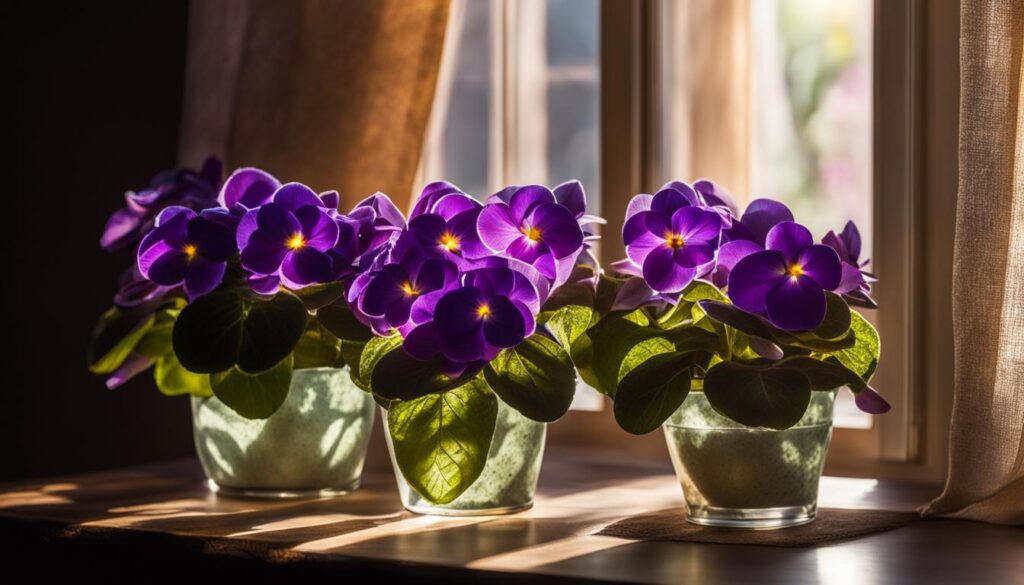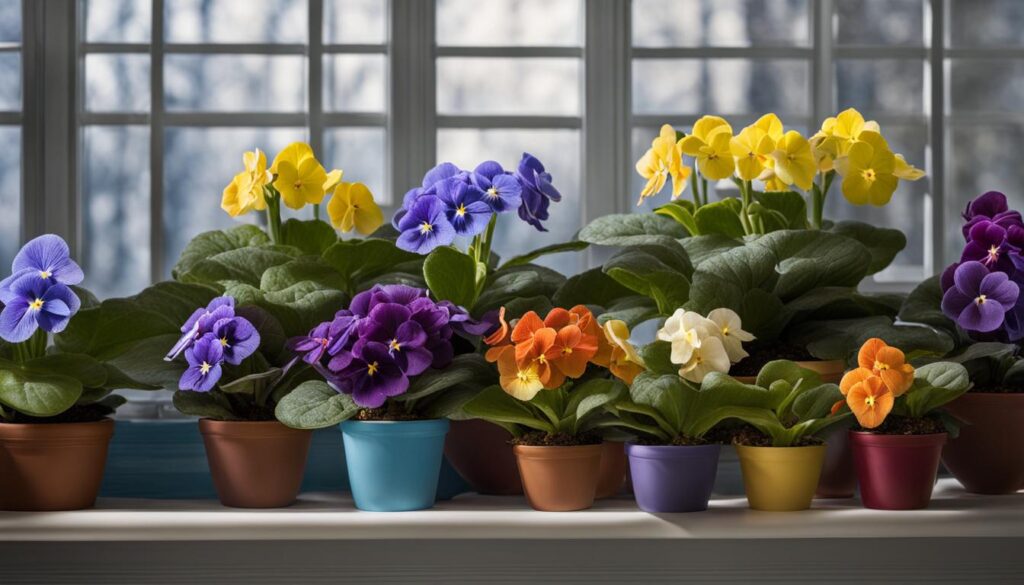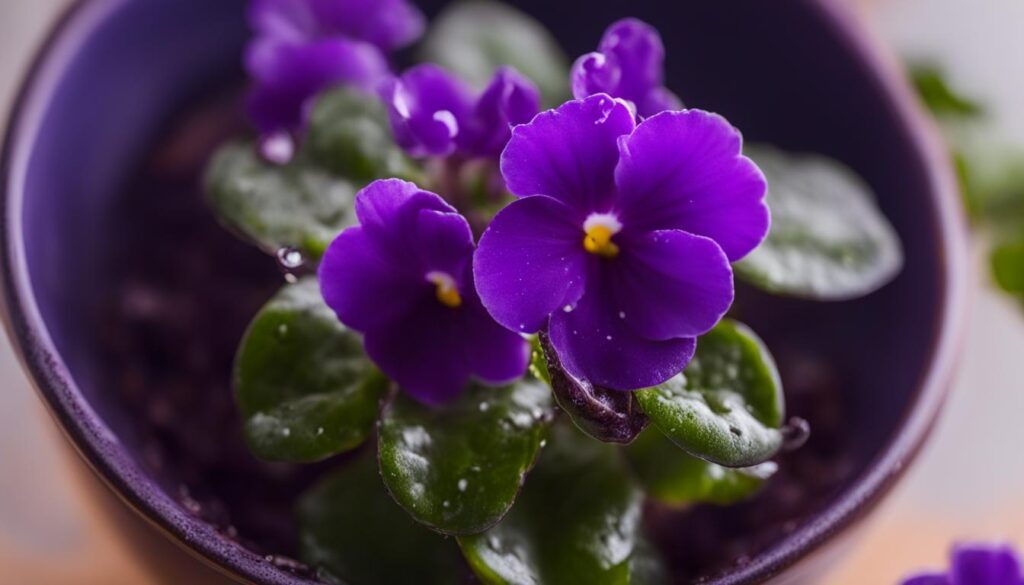African violets are cherished indoor plants, prized for their vibrant blooms and velvety leaves. These charming houseplants require specific care to achieve optimal growth and continuous blooming, even during the winter months. One crucial aspect of their care is understanding their sunlight needs and providing them with the right balance of light and shade. In this guide, we will delve into the details of African violets’ sunlight needs, including the importance of indirect light and the role of proper lighting in enhancing bloom growth.
Post Summary
- African violets require indirect sunlight for optimal growth and blooming.
- Direct sunlight can damage these plants’ leaves, so proper lighting is essential.
- An east- or north-facing window is the best location for these houseplants.
- During the winter, artificial grow lights can supplement daylight for African violets.
- Proper lighting, temperature, hydration, and fertilization all contribute to a healthy, thriving African violet.
Discovering the Beauty of African Violets
African violets captivate with their velvety foliage and vibrant flowers. To maintain their beauty, one must select healthy plants, repot them correctly, water carefully, and fertilize regularly. To achieve bountiful blooms and support growth, the plant’s environment must cater to its preferences for light and moisture.
The plant should be placed in an indirect light source to prevent leaf damage and spur growth. Select a growing mix that supports good drainage to prevent root rot. When watering, room temperature water is essential to avoid root shock. Lastly, keeping the plant well-nourished with a balanced diet of African violet-specific fertilizer will keep it blooming regularly.
- Select vibrant and healthy plants for a beautiful indoor garden display.
- Place your African violets in an area with ample indirect light to encourage blooming.
- Choose a growing mix that supports good drainage and overall plant health.
- Water carefully using room temperature water to avoid root shock and maximize nutrient uptake.
- Fertilize regularly to maintain their beauty and support healthy growth.
| Selection | Light | Soil Mix | Watering | Fertilizing |
|---|---|---|---|---|
| Healthy plants with vibrant blooms and velvety foliage | Indirect light source | Well-draining growing mix | Room temperature water | African violet-specific fertilizer |
Creating the perfect environment for your African violets ensures they continue to showcase their stunning beauty. With proper care, dedication, and consistency, these charming plants will flourish and enhance your indoor garden year-round with their vibrant blooms and soft, velvety leaves.
The Ideal Lighting for Thriving African Violets
African violets require bright light for optimal growth, yet must be shielded from direct sunlight that can cause leaf burn, inhibit growth, and damage flowers. To ensure they receive the correct amount of light, they should be placed in locations that provide ample indirect light, such as behind shades or sheer curtains during the warmer months. It is also important to rotate the plant weekly for uniform light exposure.
Indirect Sunlight Versus Direct Sunlight
While African violets need bright light to thrive, this does not necessarily mean direct sunlight. Indirect sunlight is essential for their health, as this helps prevent leaf burn and damage to the flowers. On the other hand, direct sun exposure can have the opposite effect, causing harm to the plant’s delicate foliage.
Choosing the Best Window Orientation for Your Plant
The optimal window orientation for African violets is north or east-facing to avoid the harsh sun. In warmer seasons, these orientations prevent burning, while in winter, south or west-facing windows can be more suitable due to less intense sunlight. Ensuring African violets window orientation is considered will help you maintain an even, symmetrical rosette form.
| Orientation | Benefits | Drawbacks |
|---|---|---|
| North-facing window | Provides diffused light most of the day | May require additional grow lights during winter |
| East-facing window | Offers gentle morning sunlight, ideal for African violets | May need to adjust plant placement to prevent afternoon sun exposure |
| South-facing window | Provides ample sunlight during winter months | Too intense for African violets in summer |
| West-facing window | Can supply more light during winter | Direct afternoon sunlight may cause burning in warmer months |
Winter Sunlight Considerations for African Violets
In winter, when sunlight is less potent, African violets may benefit from more direct exposure to facilitate growth and blooming. Grow lights can be a valuable addition during the dark months, and they should be set up at least a foot above the plant while ensuring they are not too warm. Properly arranged, grow lights can simulate sunlight while preserving dark periods essential for bloom stimulation.
- Choose LED or fluorescent grow lights for energy efficiency and less heat production.
- Provide 12-14 hours of light per day for optimal growth.
- Monitor temperature to ensure it remains within the African violets’ comfort zone.
Temperature Preferences for African Violets
African violets thrive in a temperature range that aligns with typical human comfort levels. These plants prefer daytime temperatures between 70-80°F and nighttime temperatures of around 65-70°F, conditions usually found in indoor environments. Consistent temperature maintenance contributes to their vibrant blooming and overall health.
Understanding the African violets’ temperature preferences is essential for creating an ideal indoor environment for their growth. The table below highlights the optimal temperature ranges for African violets during day and night.
| Temperature Range | Daytime | Nighttime |
|---|---|---|
| Optimal Range | 70-80°F | 65-70°F |
Creating an indoor temperature comfort zone is vital for the wellbeing of African violets. Maintaining these temperatures helps ensure that your plants experience the optimal conditions necessary for optimal bloom growth and overall health. Here are some tips to achieve that:
- Invest in a digital thermometer that accurately measures the temperature of the room where your African violets reside to understand whether it’s within their comfort range.
- Consider placing the plants near a window, as it helps maintain a steady temperature throughout the day and night.
- Pay attention to fluctuations in temperature when heating or air conditioning systems are in use, and adjust accordingly to ensure African violets remain within their optimal temperature range.
- Invest in temperature control devices, such as thermostats, to help regulate the conditions in your indoor environment.
By closely monitoring the African violets temperature range and ensuring that it falls within their ideal comfort zone, you will provide your plants with the optimal conditions for vibrant blooms and healthy growth.
Watering Tips: How to Properly Hydrate African Violets
Proper hydration of African violets is essential for maintaining their health and beauty. This section presents you with various African violets watering tips and best practices for ensuring optimal moisture levels. Always remember that overwatering can be just as harmful as underwatering, so finding the right balance is crucial.
The Best Practices for Bottom Watering
When it comes to hydrating African violets, bottom watering is the preferred technique. This method allows the plant to absorb water through its roots while keeping the foliage dry, thus reducing the risk of rotting. Below are detailed steps on how to perform bottom watering for your African violets:
- Fill a shallow container or saucer with room temperature water. Make sure that the water is not too cold or hot, as this can shock the plant’s delicate roots.
- Place the African violet pot in the container or saucer, allowing the plant to soak up the water through the drainage holes in the bottom for about one hour.
- After an hour, remove the plant from the container and let any excess water drain out. It is essential to avoid waterlogged soil, as it can lead to root rot.
- Allow the soil to dry out before repeating this process. Generally, African violets need to be watered every 7-14 days, depending on the environment. Be sure to monitor your plant closely and adjust your watering frequency as needed.
When bottom watering, you can also use a wick system, which involves attaching a wick to the bottom of the pot and submerging it in water. This method ensures continuous hydration, providing optimal moisture levels for your African violets.
Another crucial aspect of keeping African violets healthy is air circulation. It helps to avoid excess moisture on their leaves, preventing potential rot. Good air circulation can be achieved by keeping enough space between your plants and occasionally using a fan to create airflow.
In conclusion, proper hydration practices play a significant role in the overall health of your African violets. By following the recommended bottom watering techniques, ensuring appropriate air circulation, and monitoring moisture levels, you can help your beautiful African violets thrive and bloom for years to come.
Nourishing Your African Violets with the Right Fertilizer
Providing your African violets with the proper nutrients is essential for their overall health and bloom vitality. An excellent approach would be to utilize a specially formulated African violets fertilizer designed to boost blooming and enhance nutrient uptake, leading to a healthier and more vibrant plant.
One critical aspect to consider when nourishing your African violets is the need for higher phosphorus content. This is because phosphorus plays a significant role in promoting flowering, and thus, fertilizers rich in it tend to encourage bloom boosting.
When it comes to applying fertilizer, a balanced strategy is recommended. You can use a liquid African violets fertilizer at one-quarter strength with each watering or at full strength every two weeks during the growing season. This will provide your plants with all the essential nutrients they need to thrive.
- Find a reputable brand of African violets fertilizer, ideally one that is specially formulated to cater to the unique needs of these plants.
- Choose a balanced fertilizer that is high in phosphorus content to encourage blooming.
- Follow the appropriate fertilizer application schedule to ensure your plants receive optimal nutrient uptake.
However, it is crucial not to over-fertilize your African violets, as this can adversely affect their health. Over-fertilization is a common issue that many African violet enthusiasts encounter, and it can lead to various problems, including root damage and even plant death.
To avoid over-fertilization and to maintain the overall health of your African violets, keep track of the fertilization schedule and adjust it as necessary based on the health, growth, and visual appearance of your plants.
Repotting African Violets: Timing and Techniques
African violets perform best when root-bound and should only be repotted when necessary, usually in pots that are one-third to half the diameter of the plant for optimal blooming. It’s essential to select the right pot size and use proper potting soil to ensure the growth and health of African violets. In this section, we’ll discuss the best timing and techniques for African violets repotting, including choosing a snug pot size and switching to fresh soil.
Why and When to Repot?
Some common reasons for repotting African violets include:
- Outgrown their current pot
- Plant structure is off-balance due to lopsided growth
- Roots are growing outside the pot or through drainage holes
- Soil is old or compacted, affecting water drainage and aeration
Typically, African violets should be repotted annually to ensure they remain healthy and thriving.
Choosing the Right Pot Size
A snug pot size is essential for the health and bloom of African violets. The ideal pot size should be one-third to half the diameter of the plant. Shallow pots are preferred for their benefits in drainage and aeration, ensuring that the roots receive the right amount of water and air.
Using the Proper Soil Mix
It’s important to use the right potting mix when repotting African violets. An African violet-specific mix or a well-draining general mix is ideal. Fresh soil should be used to promote the best growing environment for your plant.
- Water the plant thoroughly one day before repotting to ensure the roots are moist and pliable.
- Gently remove the plant from its current pot, being careful not to damage roots.
- Trim off any dead or damaged roots.
- Place a small amount of fresh soil mix in the bottom of the new pot.
- Center the plant in the new pot, ensuring the crown is slightly above the soil line.
- Fill the pot with fresh soil mix, gently pressing it down around the roots.
- Water the plant lightly to settle the soil.
Repotting your African violets with proper timing and technique ensures they remain healthy and vibrant with abundant blooms. Regular care, including appropriate repotting practices, will cultivate a thriving indoor garden of African violets to brighten your home and lift your spirits.
How Does Sunlight Affect the Use of Fertilizer for African Violets?
Sunlight plays a crucial role in the effectiveness of fertilizer for African violets. Adequate sunlight helps the plants utilize the nutrients from the fertilizer, promoting healthy growth and vibrant blooms. Insufficient sunlight can lead to poor absorption of the fertilizer, affecting the overall health of the African violets.
Conclusion
In conclusion, caring for African violets requires attention to detail in providing the ideal plant environment, allowing them to become a colorful addition to your indoor gardening space. These beautiful plants need specific conditions to flourish, such as the right amount of indirect sunlight and comfortable temperatures.
Proper hydration and a nutrient-rich fertilizer play vital roles in fostering healthy growth and vibrant blooms. By following these guidelines, your African violets can remain lush and dazzling for years to come, showcasing their stunning flowers and velvety foliage.
With a bit of dedication and effort, you can experience the joy of successfully nurturing African violets in your home, ensuring they reward you with their captivating charm and elegant beauty.












